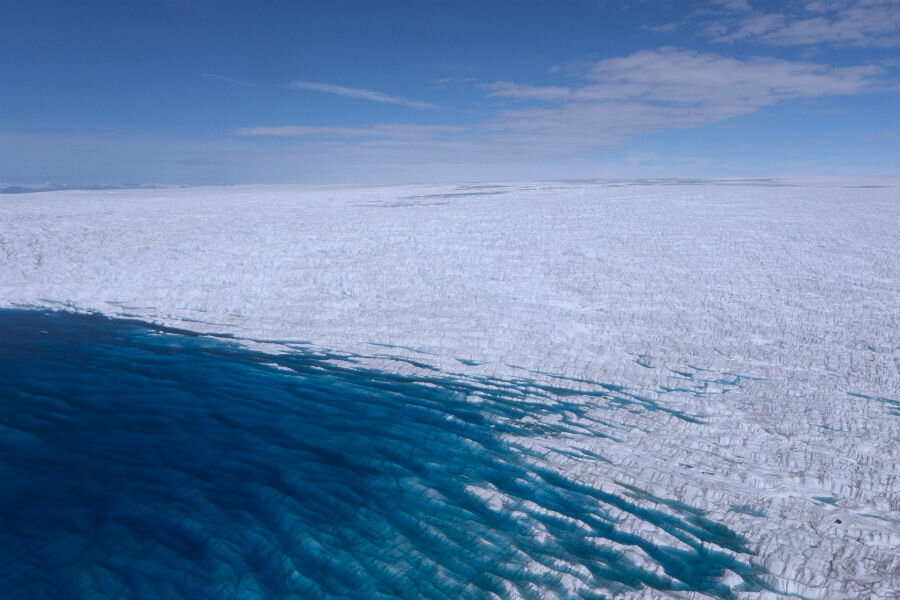Will Greenland's ice sheet slide into the sea?
Loading...
Greenland’s ice sheet may be more vulnerable to climate change than previously thought, according to new models developed by researchers at the University of Cambridge in England.
For the first time, glaciologists at the University of Cambridge’s Scott Polar Research Institute incorporated new information about the porous characteristics of the sediment underneath Greenland's ice sheet in computer modeling.
Their findings, published Monday in Nature Communications, suggest that not only is the continental glacier vulnerable to the warming climate, but also to intensified rain events.
Previous models relied on a pivotal assumption that much of the earth underneath the massive glacier is hard rock. But recent seismic testing conducted by researchers at Aberystwyth University in Greenland revealed that at least some of the ice sheet sits on porous sediment. According to the new models, this difference in ground consistency makes a big difference in how the ice sheet sheds melt water in the summer months.
Every summer, portions of the continental glacier melt and drain into the Arctic Ocean; and every winter snow falls and rebuilds the ice sheet. Until recently, the two processes tended to balance each other out. Since the mid-1990s, however, the net effect has been an overall loss, says study author and Cambridge glaciologist Poul Christoffersen.
“Year after year, there is more melt by the margin and less snow in the interior,” Professor Christoffersen says. “In recent years, we have seen the summer season lengthen both in terms of when the melt starts and when the fjords break up.”
In summer months, melt water collects atop the ice sheet in enormous lakes. During heavy rain events, these lakes swell even larger. Eventually, these lakes become heavier than the ice they are sitting on. The water actually fractures the ice and begins to drain underneath the glacier, just as if someone had pulled the plug in a bathtub.
“We aren’t talking about a slow and steady drain here. We are taking a Niagara Falls type discharge,” Christoffersen says.
Glaciologists can’t observe directly what happens to all that water underneath the ice sheet so they rely on modeling. In portions of the ice sheet sitting atop hard rock, the water likely carves a channel and flows directly to the surrounding ocean, as suggested by previous models.
However the new models suggest that in areas where softer ground lies underneath the ice sheet, a small portion of the water – only about 10 percent – gets absorbed into the ground while the majority of the water gushes outward in all directions, Christoffersen explains.
Climatologists have warily watched Greenland's 650,000-square-mile ice sheet as a harbinger of global warming for decades. If warming trends continue, the amount of melt water flowing into the Arctic Ocean could induce sea level rise all over the world.
"When these large ice sheets melt, whether that's due to seasonal change or a warming climate, they don't melt like an ice cube," Marion Bougamont of Cambridge's Scott Polar Research Institute, who led the research said in a statement Monday. "Instead, there are two sources of net ice loss: melting on the surface and increased flow of the ice itself, and there is a connection between these two mechanisms which we don't fully understand and isn't taken into account by standard ice sheet models."
The new models also suggest that over-saturation actually weakens the sediment and may speed up the flow of the ice.
While ice appears to be solid to the naked eye, it is really a fluid that continues to flow while frozen, albeit more slowly than it does when it is warmer, explains Andreas Muenchow, a polar oceanography professor at the University of Delaware in Newark.
“Ice is a fluid – not a fluid like water, which spreads out really quickly; It’s more of a fluid like honey is a fluid,” Professor Muenchow says. “If you make honey warm it flows really well, if you put it in the freezer it hardly flows at all.”
Christoffersen posits that the acceleration of the ice flow could potentially make the ice sheet thinner and therefore more prone to melting, which could eventually become a self-perpetuating cycle.
Confirming that theory would take extensive research and fieldwork throughout Greenland’s ice sheet, Muenchow says.
“This paper has wonderful physics, but it’s an idea that focuses on one specific detail that may or may not be relevant for the rest of Greenland,” Muenchow explains. “You need data and observations to test the idea and the model.”






